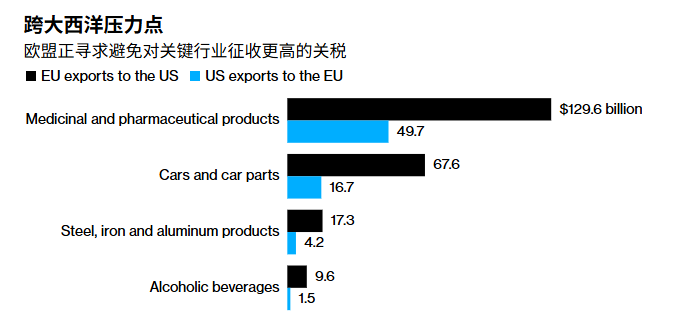The EU this week is seeking to reach a provisional trade deal with the US that would allow it to lock in a 10% tariff rate after the August 1 deadline while the two sides negotiate a permanent agreement.
According to informed sources, the EU is seeking exemption from the 10% tariff on certain key products, including aircraft, aircraft parts, as well as wine and spirits. It is expected that as part of the agreement’s principles, the EU will offer some form of concession.
In early Asian trading on Tuesday, the euro rose by 0.3% at one point as traders reacted to a Politico report that the US-proposed deal would maintain a 10% benchmark tariff but offer exemptions for sensitive industries such as aircraft and spirits. Investors believe that a 10% trade tariff level is more acceptable compared to other trading partners, which is expected to boost the euro.
The European Commission, which is in charge of the EU’s trade affairs, informed member states of the progress of the negotiations on Monday. A spokesperson for the European Commission refused to comment on the ongoing negotiations.
Billy Leung, an investment strategist at Global X ETFs in Sydney, said: “Europe is the region that is truly close to reaching a good deal.” He added that the situation in the EU seems better than that of the US’s trading partners such as Japan and South Korea.
The United States announced on Monday that the general tariffs originally set to take effect on July 9 will be postponed until at least early August. For the European Union, if no agreement is reached in advance, tariffs on almost all products exported to the United States will jump to 50% in early August.

Trump imposed tariffs on almost all of America’s trading partners, claiming that he wanted to restore domestic manufacturing, needed to cover the cost of tax cuts and extensions, and prevent other countries from taking advantage of the United States.
According to informed sources, the EU is still urging the US to grant quotas and exemptions to effectively reduce the 25% tariffs imposed by Washington on automobiles and auto parts as well as the 50% tariffs on steel and aluminum. However, breakthroughs in these tariff areas will not occur immediately.
However, people familiar with the matter said that the two sides are discussing a so-called offset mechanism, which would allow companies that produce cars in the United States to export a certain number of cars duty-free.
Bloomberg previously reported that some officials were concerned that such an arrangement might lead to investment and production moving across the Atlantic.
Any initial agreement is likely to be short and not legally binding. Both sides also hope to reach consensus on non-tariff barriers, digital trade and economic security.
In addition to the so-called reciprocal tariffs and industry-specific taxes on automobiles and metals, the United States is also striving to impose tariffs on other industries, including pharmaceuticals and semiconductors.
Member states have differences over the extent of imbalance that the EU should accept in the agreement. Some countries call for reaching an agreement as soon as possible, while others hope that the EU will take countermeasures and negotiate from a position of strength.
According to a previous report by Bloomberg, the EU will assess the final outcome and decide at this stage the extent of asymmetry it is willing to accept and whether any rebalancing measures are needed.
The European Union has approved tariffs on $24.6 billion worth of US goods, which can be implemented quickly in response to Trump’s metal tariffs. These tariffs target politically sensitive US states, including soybeans, agricultural products, poultry and motorcycles from Louisiana (the home state of House Speaker Mike Johnson).
The EU has also prepared an additional list of tariffs, which will impose duties on US products worth 95 billion euros in response to Trump’s so-called reciprocal taxes and auto tariffs. These tariffs will target industrial products including Boeing aircraft, US-made cars and bourbon whiskey. The EU is also consulting with member states to identify strategic sectors where the US relies on the EU and possible measures beyond tariffs, such as export controls and restrictions on procurement contracts.


